Outdoor Murals of Ottawa Canada - Past Tense
Here are the murals that had their day in the Ottawa sun and have been erased or destroyed.

This skating shack at the Hunt Club/Riverside Community Center, now demolished, shows the
importance of substrate preparation when producing a mural. The primer used was not opaque to UV,
so the chipboard siding deteriorated under the paint, especially on the sides exposed to sun and
the base that was covered by snow in winter. Design by Eric Desarmis, painting by youth from the
community and Canterbury High School, fall 2003.
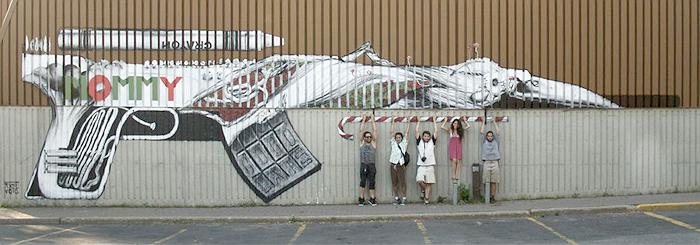
This mural was on Le Patro, a recreation centre on Cobourg Street. The image grew out of a
workshop for young people held on the theme of love: home, mothers, flowers, birds and music were
discussed. The artist, Alejandro Dorda Mevs, incorporated these love symbols into the silhouette
of a weapon in order to disable it. It is the imagination, hope, creativity and love of the
children of Le Patro that destroy the violence of the gun, and give us hope for the future. The
trigger is part of a musical instrument, the gun scope is a crayon, the barrel is filled with birds
and flowers, MOMMY is painted across the casing, the bullet clip is a chocolate bar and a candy
cane forms the lower bottom part of the barrel. Meanwhile, the background silhouette of the
original gun reminds us that there will always be guns in need of transforming by love.
The children of Le Patro understood, as you can see. Unfortunately, a few philistines who saw only
a gun, and not the messages of love overcoming evil, had their way. The mural was destroyed by
city staff a few days after it was completed. This photo was taken by the artist at the time of
painting.

Much of the 2010 Lowertown Community Resource Centre Art Beat mural on the facilities building
of Jules Morin Park was demolished with the building in 2012; two sections survived and were moved
to 201 Friel St. Photo: City of Ottawa

[Map]
159 Montreal Road. Here is what the mural looked like before the city allowed it to be obscured by
a patio structure. Artist: Karole Marois.
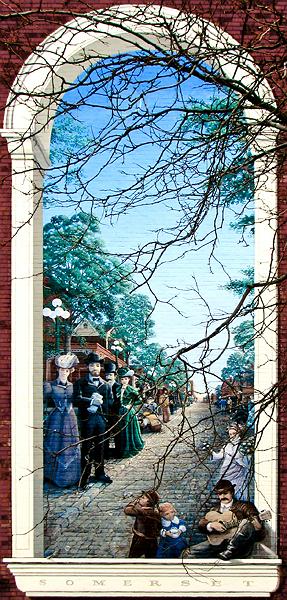
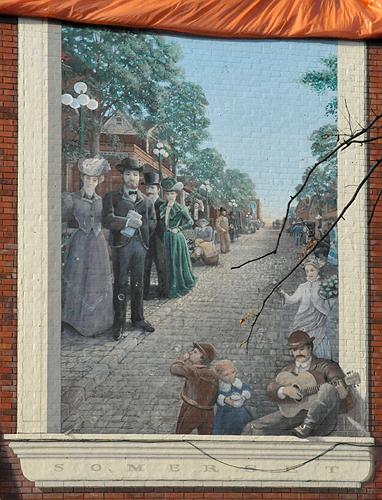
[Map]
Somerset & Bank. The house was partly demolished by the city before being stopped by a court
order. At left is the way it looked in 2007; at right is what is left in 2010. Artist: Robert
Dafford.
Left photo: Robin Kelsey.

Edgewood corner of Richmond, destroyed by an uncaring new owner. The leftmost image is of a
girl who worked in the
building and came out for a smoke. In an interaction typical of Shaun's involvement with
the community he paints for, he painted out the cigarette because the girl's mother didn't
know she smoked! The next image is of the artist's niece with her cat, while the
figure walking out of the trompe d'oeil alleyway is a local character known as the "Duke of
Westboro", famous for his brightly coloured suits. The figure working on the "door" is the
artist, the guitar player the son of the building owner. The two small dogs shown just
happened to be walked by during the painting of the mural. The only real windows and door are
the door with the
purple pot painted on it and the two windows each side with matching curtains. This
mural could only be appreciated early Sunday mornings as it was blocked by parked cars at
all other times because the city refused to limit parking in front of it.
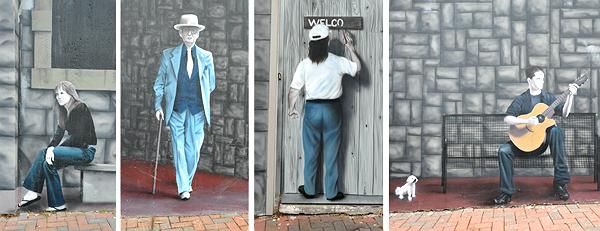
The smokeless girl, the 'Duke', the artist, a dog and the owner's son.
Artist: Shaun McInnis.

294 Richmond. This was painted by Dan Metcalfe in atonement for graffiti. It's now erased.
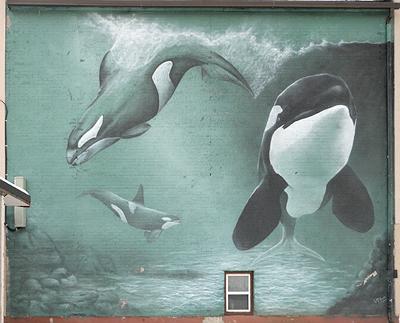
This incredible mural covered the entire back of a three storey apartment block at 449 Churchill.
It's now covered by cheap aluminum siding. Artist: Shaun McInnis.
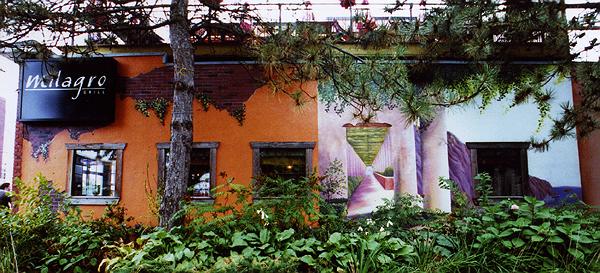
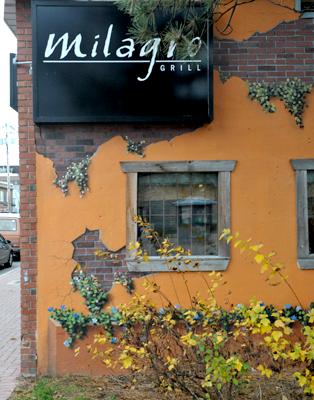 This mural at 361 Richmond has now been painted over by a new owner. Apart from the brick veneer
at the left edge, the illuminated sign, the wood-framed windows and fall-yellowed shrubs,
everything in the detail at right was painted: bricks, peeling stucco, ivy and all. You had to see
and feel it to appreciate how remarkable this mural was. Artist: Shaun McInnis.
This mural at 361 Richmond has now been painted over by a new owner. Apart from the brick veneer
at the left edge, the illuminated sign, the wood-framed windows and fall-yellowed shrubs,
everything in the detail at right was painted: bricks, peeling stucco, ivy and all. You had to see
and feel it to appreciate how remarkable this mural was. Artist: Shaun McInnis.

The Westboro Dairy began business in the 1930's and continued under
several owners for many years. An old fashioned dairy farm was
followed by a closed door painted as though it were open. The "windows" each side contained
old style milk bottles shown to the artist as he was painting by a passerby who
collected them. A team of horses coming from the farm with cans full of milk was
followed by a hitching post and a few more authentic cans of the period. The only real
windows were the two leftmost and the rightmost. The entire building has been replaced by a new
much larger one. Artist: Shaun McInnis.
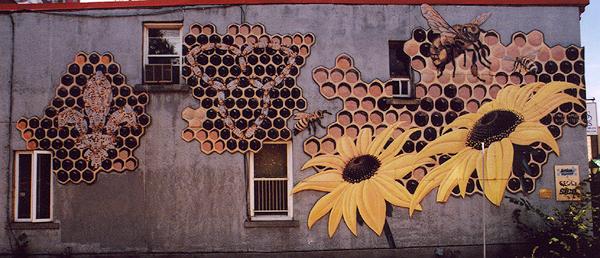
This mural at 240 Montreal Road has vanished with the demolition of the building in 2019. It was
the former Action Logement building with the symbols for Ontario and la Francophonie joined with
busy bees searching for food symbolizing their work. Artists: Colin McGill & Karen Churma.
mural home page











 This mural at 361 Richmond has now been painted over by a new owner. Apart from the brick veneer
at the left edge, the illuminated sign, the wood-framed windows and fall-yellowed shrubs,
everything in the detail at right was painted: bricks, peeling stucco, ivy and all. You had to see
and feel it to appreciate how remarkable this mural was. Artist: Shaun McInnis.
This mural at 361 Richmond has now been painted over by a new owner. Apart from the brick veneer
at the left edge, the illuminated sign, the wood-framed windows and fall-yellowed shrubs,
everything in the detail at right was painted: bricks, peeling stucco, ivy and all. You had to see
and feel it to appreciate how remarkable this mural was. Artist: Shaun McInnis.

